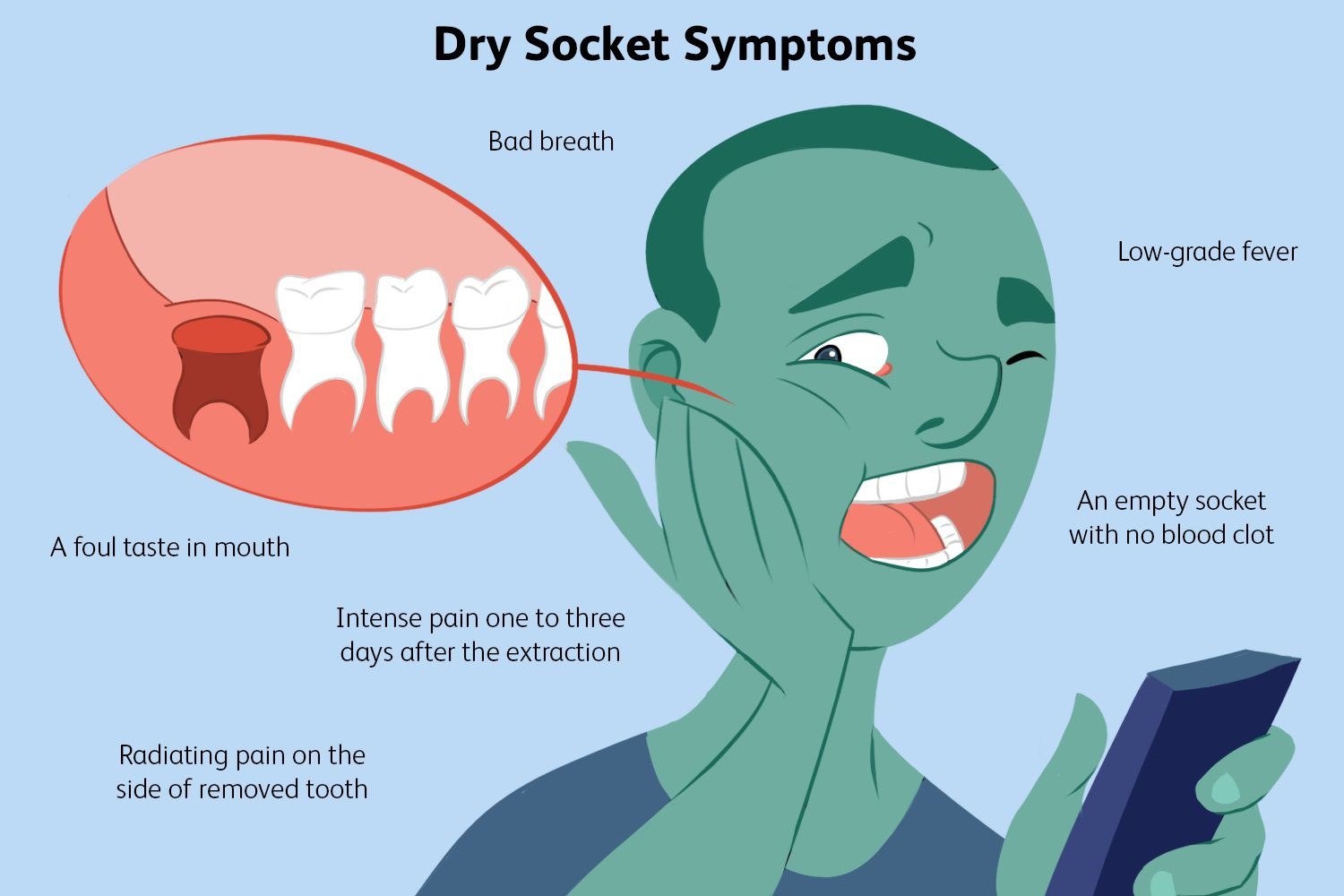Detecting Dry Socket Vs. Normal is difficult. There are no clear signs to look for, but if you can see the extraction site, you might be able to spot the difference. Healthy sockets have a clot in the middle. On the other hand, a white socket shows exposed bone and lost blood clots. The clot can be dissolved by infection or bacteria, leading to color change.
Pain in the jaw and ear
A dry socket is a common dental problem that results from the extraction of a wisdom tooth. This type of pain is similar to the pain experienced during tooth extraction but is not caused by the same conditions. When certain bacteria attack the clot in the socket, the area is exposed and begins to swell and develop a foul smell. The area also becomes inflamed and may develop food debris. Depending on the severity of the pain, the infection may develop and require antibiotic treatment.
Patients suffering from dry sockets experience more pain than before the surgery, particularly in the lower jaw. The pain may radiate to other areas of the jaw and neck, and in some cases, bad breath is the result. Dry sockets can be caused by poor oral hygiene practices such as aggressive rinsing and spitting, smoking, or taking oral contraceptive pills. The more time a clot has to develop, the more painful the condition. However, antibiotics do not significantly reduce the incidence of dry socket.
Treatment of dry sockets depends on the severity and duration of pain. While the pain associated with this dental condition is often mild and short-lived, you may have to visit the dentist again to get a second opinion. Your dentist will likely prescribe you over-the-counter anti-inflammatory drugs (NSAIDs) and show you how to apply ice to the affected area to alleviate discomfort. Most dry sockets heal independently, but you should seek immediate medical attention if your pain persists for more than a few days.
Inflammation
What are dry sockets, and how do you differentiate between them? A dry socket is an inflammation of the bone where a tooth was extracted. Following extraction, a blood clot forms in the socket. This protects the nerves and bone underneath the tooth. However, dry sockets can occur if the blood clot dissolves too quickly or never forms. As a result, the area becomes exposed and can lead to infection. In addition, food particles can get trapped in the extraction site, slowing the healing process. This debris can cause further complications, such as infections.
The clot is not completely dissolvable in the basic dry socket and may look dark and exposed. Rarely, fever and enlarged lymph nodes are seen. Another form of dry socket is superficial alveolitis marginal, characterized by covering bone tissue. Inflamed bone tissue in the socket may also cause pain when chewing. The inflammation in bones at other locations can be more serious.
Moreover, if a dry socket lesion is present, it may reveal a bone underlying the occlusal surface. The exposed bone could be a septum protruding from the occlusal perimeter of the socket. If the exposed bone is located superiorly, it is the last part of the socket to be covered by epithelium. Food particles can erode the epithelium growing over the exposed bone. Consequently, mechanical stimulation can cause acute pain.
Bacteria
There is no single cause of dry socket lesions. There is a complex interaction between many factors, but bacteria are not the only factor. Increasing bacterial count around extraction sockets may reduce dry socket incidence by about 50 percent. However, reducing bacterial counts may not be enough to prevent dry sockets. Many of the factors associated with a dry socket are unknown. A thorough understanding of how bacteria cause dry socket lesions will be essential for developing effective treatments.
Home care for dry sockets includes rinsing the mouth frequently with warm salt water and following a soft diet to avoid trauma to the socket. Carbonated drinks, alcohol, and drinking through a straw can interfere with the clotting process. Special medication and an ointment can be prescribed for dry socket prevention. However, a dry socket is usually not an emergency and can be prevented with simple home care.
The bacterial activity in the dry socket lesion is counteracted by plasmolysis. The clot dissolves under the influence of plasminogen. This process causes a temporary stoppage of blood flow in the socket and is associated with a loss of the clot. The bacteria present in a dry socket are essential to the healing process of the tooth. However, it is not necessary to stop the bleeding immediately.
Mechanical causes
A common problem associated with tooth extraction is a complication known as dry socket. This condition results from the loss of the blood clot that normally forms in the socket. The clot protects the nerves and bone underneath the tooth, but the socket may not heal properly if the clot is absent. Several causes of dry socket exist, from bacterial infections to aggressive rinsing, smoking, and sucking.
One of the most common causes of dry sockets is tobacco use. Nicotine is a known blood clot inhibitor. Smokers’ mouths are especially susceptible, as the cigarette is made up of nicotine, which inhibits blood flow to the socket. Other causes of dry socket include improper oral care, such as aggressive mouthwash, sucking through a straw, or spit. Furthermore, aggressive rinsing and spitting are known to dislodge the blood clot and cause the socket to become dry.
Besides a poor blood supply, other causes of dry socket include hormonal changes and poor oral hygiene. Older people are more prone to the condition, as their jawbone tends to become denser as they get older. In addition, menstrual hormones and oral contraceptives have been linked to a higher risk of developing the condition. And finally, being a woman may affect the body’s blood supply to the area where the extraction occurs.
Smoking
You’re at a higher risk of the dry socket if you are a smoker. Tobacco contains nicotine, which affects blood circulation and decreases oxygen levels in the blood. This, in turn, slows down the healing process. Additionally, tobacco products contain additives that can introduce foreign materials into an open wound in the mouth, making it more likely to develop an infection. In addition, smoking can irritate the healing area and irritate tissues.
Even if you don’t smoke after having your tooth extracted, smoking can negatively affect the healing process. When you smoke, you’re pushing your body backward. The sucking motion of cigarettes will dislodge the blood clot needed to support the healing site. That can lead to infections and dry sockets. Afterward, you’ll have to wait for the natural healing process to complete before you can smoke again.
One way to prevent dry sockets after a tooth extraction is to quit smoking before the procedure. Smoking causes the extraction site to become exposed to bacteria and pain. Moreover, a dry socket may exacerbate other problems caused by tooth extraction. Tobacco and nicotine in cigarettes can delay healing and exacerbate the pain. Tobacco and e-cigarette smoke can irritate the extraction site. The result of the inflammation is often excruciating pain.
Normal healing
The time needed to heal a dry socket is ten to seven days, but the process may take longer if the blood clot isn’t dislodged or never formed. Getting treatment as soon as possible may also reduce the healing time. However, there’s no guarantee that dry sockets will heal completely, and a small number of cases will last longer than a week. If you experience severe pain, visit a doctor for a diagnosis.
One cause of dry socket is a high-stress extraction, which causes the alveolar bone surrounding the tooth to undergo high-stress fractures. The result is necrosis of the osteoblasts that line the socket. Osteoblasts are responsible for lining the socket with blood, so the clots may dislodge if there are damaged blood vessels. Those who smoke and use oral contraceptives are also at increased risk of dry sockets.
Unlike a normal healing process, dry sockets may persist even after the first few days. In these cases, the clot may not reform, and the bacterial biofilm in the socket may prevent the healing epithelium from forming contact with the exposed bone. In addition, the presence of food particles can lead to an unpleasant taste and odor in the mouth and may delay healing. Both of these factors contribute to the discomfort that a dry socket causes.

